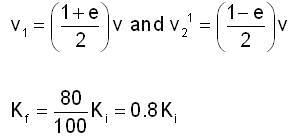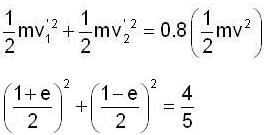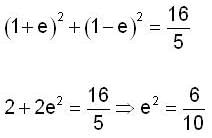Physics Exam > Physics Questions > A ball of mass m moving at a speed v makes a ...
Start Learning for Free
A ball of mass m moving at a speed v makes a head-on wllision with an identical ball at rest. The kinetic energy of the balls after the collision is 80% of the original. Find the coefficient of restilation.
Correct answer is '0.77'. Can you explain this answer?
| FREE This question is part of | Download PDF Attempt this Test |
Verified Answer
A ball of mass m moving at a speed v makes a head-on wllision with an ...
Let 









Most Upvoted Answer
A ball of mass m moving at a speed v makes a head-on wllision with an ...
Given:
- Mass of the balls: m
- Initial velocity of ball 1: v
- Final kinetic energy of the balls after collision: 80% of the original
To find:
- Coefficient of restitution
Explanation:
The coefficient of restitution (e) is a measure of the elasticity of a collision between two objects. It is defined as the ratio of the relative velocity of separation to the relative velocity of approach after the collision.
Step 1: Initial Kinetic Energy
Before the collision, the initial kinetic energy of the system can be calculated using the formula:
KE1 = (1/2)mv^2
Step 2: Final Kinetic Energy
After the collision, the final kinetic energy of the system is given as 80% of the initial kinetic energy:
KE2 = 0.8 * KE1
Step 3: Conservation of Momentum
Since the collision is head-on, the momentum is conserved. Therefore, the total momentum before the collision is equal to the total momentum after the collision. The momentum of an object is given by the product of its mass and velocity.
Initial momentum = mv
Final momentum of ball 1 = mv1
Final momentum of ball 2 = mv2
Since the second ball is initially at rest, its final velocity will be v2 = -v1.
Step 4: Using Kinetic Energy and Momentum Equations
Using the equations for kinetic energy and momentum, we can write:
KE1 = (1/2)mv^2
KE2 = (1/2)m(v1^2 + v2^2)
= (1/2)m(v1^2 + (-v1)^2)
= (1/2)m(2v1^2)
= mv1^2
Since KE2 = 0.8 * KE1, we can equate the two equations:
mv1^2 = 0.8 * (1/2)mv^2
v1^2 = 0.8 * v^2
v1 = √(0.8)v
Step 5: Coefficient of Restitution
The coefficient of restitution (e) can be calculated using the formula:
e = |v2 - v1| / |v|
Since v2 = -v1, we have:
e = |-v1 - v1| / |v|
= 2v1 / v
= 2√(0.8)v / v
= 2√(0.8)
≈ 0.77
Therefore, the coefficient of restitution is approximately 0.77.
- Mass of the balls: m
- Initial velocity of ball 1: v
- Final kinetic energy of the balls after collision: 80% of the original
To find:
- Coefficient of restitution
Explanation:
The coefficient of restitution (e) is a measure of the elasticity of a collision between two objects. It is defined as the ratio of the relative velocity of separation to the relative velocity of approach after the collision.
Step 1: Initial Kinetic Energy
Before the collision, the initial kinetic energy of the system can be calculated using the formula:
KE1 = (1/2)mv^2
Step 2: Final Kinetic Energy
After the collision, the final kinetic energy of the system is given as 80% of the initial kinetic energy:
KE2 = 0.8 * KE1
Step 3: Conservation of Momentum
Since the collision is head-on, the momentum is conserved. Therefore, the total momentum before the collision is equal to the total momentum after the collision. The momentum of an object is given by the product of its mass and velocity.
Initial momentum = mv
Final momentum of ball 1 = mv1
Final momentum of ball 2 = mv2
Since the second ball is initially at rest, its final velocity will be v2 = -v1.
Step 4: Using Kinetic Energy and Momentum Equations
Using the equations for kinetic energy and momentum, we can write:
KE1 = (1/2)mv^2
KE2 = (1/2)m(v1^2 + v2^2)
= (1/2)m(v1^2 + (-v1)^2)
= (1/2)m(2v1^2)
= mv1^2
Since KE2 = 0.8 * KE1, we can equate the two equations:
mv1^2 = 0.8 * (1/2)mv^2
v1^2 = 0.8 * v^2
v1 = √(0.8)v
Step 5: Coefficient of Restitution
The coefficient of restitution (e) can be calculated using the formula:
e = |v2 - v1| / |v|
Since v2 = -v1, we have:
e = |-v1 - v1| / |v|
= 2v1 / v
= 2√(0.8)v / v
= 2√(0.8)
≈ 0.77
Therefore, the coefficient of restitution is approximately 0.77.

|
Explore Courses for Physics exam
|

|
Similar Physics Doubts
A ball of mass m moving at a speed v makes a head-on wllision with an identical ball at rest. The kinetic energy of the balls after the collision is 80% of the original. Find the coefficient of restilation.Correct answer is '0.77'. Can you explain this answer?
Question Description
A ball of mass m moving at a speed v makes a head-on wllision with an identical ball at rest. The kinetic energy of the balls after the collision is 80% of the original. Find the coefficient of restilation.Correct answer is '0.77'. Can you explain this answer? for Physics 2024 is part of Physics preparation. The Question and answers have been prepared according to the Physics exam syllabus. Information about A ball of mass m moving at a speed v makes a head-on wllision with an identical ball at rest. The kinetic energy of the balls after the collision is 80% of the original. Find the coefficient of restilation.Correct answer is '0.77'. Can you explain this answer? covers all topics & solutions for Physics 2024 Exam. Find important definitions, questions, meanings, examples, exercises and tests below for A ball of mass m moving at a speed v makes a head-on wllision with an identical ball at rest. The kinetic energy of the balls after the collision is 80% of the original. Find the coefficient of restilation.Correct answer is '0.77'. Can you explain this answer?.
A ball of mass m moving at a speed v makes a head-on wllision with an identical ball at rest. The kinetic energy of the balls after the collision is 80% of the original. Find the coefficient of restilation.Correct answer is '0.77'. Can you explain this answer? for Physics 2024 is part of Physics preparation. The Question and answers have been prepared according to the Physics exam syllabus. Information about A ball of mass m moving at a speed v makes a head-on wllision with an identical ball at rest. The kinetic energy of the balls after the collision is 80% of the original. Find the coefficient of restilation.Correct answer is '0.77'. Can you explain this answer? covers all topics & solutions for Physics 2024 Exam. Find important definitions, questions, meanings, examples, exercises and tests below for A ball of mass m moving at a speed v makes a head-on wllision with an identical ball at rest. The kinetic energy of the balls after the collision is 80% of the original. Find the coefficient of restilation.Correct answer is '0.77'. Can you explain this answer?.
Solutions for A ball of mass m moving at a speed v makes a head-on wllision with an identical ball at rest. The kinetic energy of the balls after the collision is 80% of the original. Find the coefficient of restilation.Correct answer is '0.77'. Can you explain this answer? in English & in Hindi are available as part of our courses for Physics.
Download more important topics, notes, lectures and mock test series for Physics Exam by signing up for free.
Here you can find the meaning of A ball of mass m moving at a speed v makes a head-on wllision with an identical ball at rest. The kinetic energy of the balls after the collision is 80% of the original. Find the coefficient of restilation.Correct answer is '0.77'. Can you explain this answer? defined & explained in the simplest way possible. Besides giving the explanation of
A ball of mass m moving at a speed v makes a head-on wllision with an identical ball at rest. The kinetic energy of the balls after the collision is 80% of the original. Find the coefficient of restilation.Correct answer is '0.77'. Can you explain this answer?, a detailed solution for A ball of mass m moving at a speed v makes a head-on wllision with an identical ball at rest. The kinetic energy of the balls after the collision is 80% of the original. Find the coefficient of restilation.Correct answer is '0.77'. Can you explain this answer? has been provided alongside types of A ball of mass m moving at a speed v makes a head-on wllision with an identical ball at rest. The kinetic energy of the balls after the collision is 80% of the original. Find the coefficient of restilation.Correct answer is '0.77'. Can you explain this answer? theory, EduRev gives you an
ample number of questions to practice A ball of mass m moving at a speed v makes a head-on wllision with an identical ball at rest. The kinetic energy of the balls after the collision is 80% of the original. Find the coefficient of restilation.Correct answer is '0.77'. Can you explain this answer? tests, examples and also practice Physics tests.

|
Explore Courses for Physics exam
|

|
Suggested Free Tests
Signup for Free!
Signup to see your scores go up within 7 days! Learn & Practice with 1000+ FREE Notes, Videos & Tests.


















